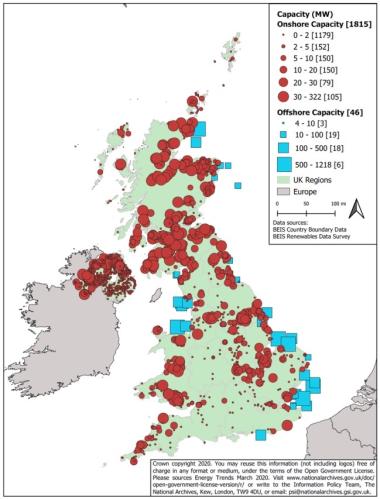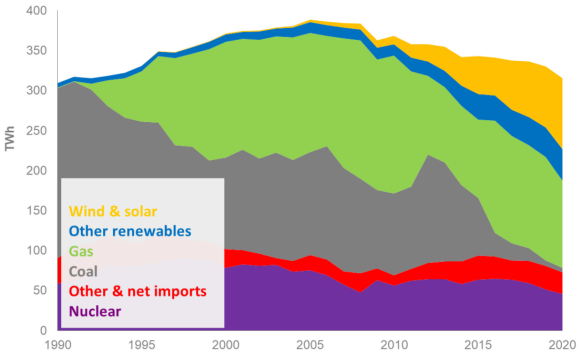UK lacks local planning staff to process faster wind rules
Wind planning reforms in England will require more staff at local authorities and contracting stakeholders to deadlines could help the UK meet its net zero targets, industry experts said.

Related Articles
In December, the UK government announced it would ease restrictions on building onshore wind projects in England in a bid to reignite activity and help meet its commitment of a net zero power sector by 2035.
To achieve these targets, UK onshore wind capacity must rise from 15 GW in 2022 to 35 GW by 2035, but development has mainly been confined to Scotland since rules in England were toughened by David Cameron's Conservative government in 2015. The government opened up contract for difference (CFD) subsidies to onshore wind and solar in 2021 but wind planning rules in England have continued to block projects.
UK onshore, offshore wind capacity in 2020
(Click image to enlarge)
Source: UK Department for Business, Energy and Industrial Strategy (BEIS)
The government will adapt the National Planning Policy Framework to permit onshore wind development where local consent is demonstrated, it said, ending rules that meant opposition from one person could block the project. A public consultation will conclude in April and local communities could benefit from wind projects through lower energy bills and even project ownership.
The new approval process is expected to lead to a surge in new project applications and experts fear a lack of resources at local planning authorities (LPAs) could delay projects. Developers also want deeper reforms to unblock larger projects.
Approval delays in Scotland and Wales, where planning regimes are already designed to accept wind farm proposals, indicate the challenge ahead in England, Frank Elsworth, Vattenfall’s Head of UK Onshore Development, told Reuters Events.
Local authorities in Scotland and Wales are “struggling to progress planning applications in reasonable timeframes," Elsworth said. In addition, England's authorities are no longer used to processing onshore wind applications, he said.
UK local planning authorities and statutory consultees "do not have the resources to deal with the high number of onshore and offshore energy and related developments that are required to deliver the transition to net zero," a spokesperson for developer RWE said.
Resource gap
The reforms in England mean local authorities will not be strictly required to designate wind farm areas in planning documents, giving them greater scope to demonstrate consent.
Historically, it has taken two to three years to receive planning approval with public enquiries adding at least a year to the process, Elsworth said.
"Ideally...we’d like to see decisions made within six months of the application being submitted," he said. "There is so much work that goes into just getting a project to the stage where a developer can apply for planning permission that we can’t afford to be waiting around."
UK electricity generation by fuel type
(Click image to enlarge)
Source: UK Department for Business, Energy and Industrial Strategy (BEIS), 2021.
Local authorities will have a short time to bulk up resources before applications start rolling in. There is currently less than 500 MW of new onshore wind capacity in England in the development phase, according to data from research firm Cornwall Insight.
Local authorities will have a large volume of projects to approve from other technologies in the planning pipeline, warned Tom Faulkner, Head of Assets & Infrastructure and Networks at Cornwall Insight. The UK government is also looking to accelerate solar deployment and battery installations are on the rise as the need for energy storage grows.
Local authorities may need to rely on external consultants in the short-term while staff are trained up on the new approval processes. Local authority resources are also required to unlock planning conditions before construction, Elsworth noted.
LPAs “would struggle to cope with a significant upswing in applications," Gary McGovern, Planning and Environment Partner at law firm Pinsent Masons, said.
Local planning departments have been under-resourced for many years and McGovern expects little additional investment in the short-term under the government's budget tightening plans.
Deadline agreements
One way to mitigate a lack of government funding would be to use planning performance agreements which allow developers to make financial contributions to local authorities, McGovern said.
These agreements between local authorities and applicants set out timescales, actions and resources for processing applications and are encouraged by central government for large or complex projects. Developers would need to factor in additional costs. To avoid bias, the funding is not used directly on the project, but for later applications.
Key stakeholders such as Natural England, Historic England, The Wildlife Trusts and some community groups, have used these agreements across a range of different projects, McGovern said.
“If a developer is willing to make financial contributions, then the consultee is usually open to that,” he said.
Reporting by Neil Ford
Editing by Robin Sayles


